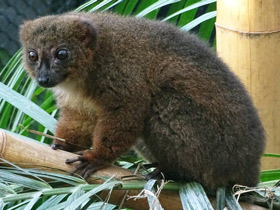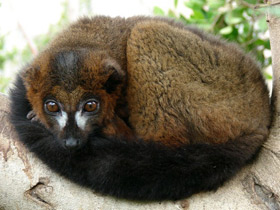The red-bellied lemur (Eulemur rubriventer)
 The red-bellied lemur (Eulemur rubriventer) is included in the IUCN Red List as Vulnerable
The red-bellied lemur (Eulemur rubriventer) is included in the IUCN Red List as Vulnerable
The red-bellied lemur (Eulemur rubriventer) is a medium-sized strepsirrhine primate with a luxuriant chestnut brown coat. This lemur is endemic to eastern Madagascan rainforests and is distinguished by patches of white skin below the eyes, giving rise to a "teardrop" effect, particularly conspicuous in the male.
The species, first identified in 1850, exhibits diurnal behaviour and marked sexual dimorphism. The red-bellied lemur has been studied extensively since the mid-1980s, primarily in Ranomafana National Park. This lemur species is designated as vulnerable according to the IUCN Red List, due to threats endangering habitats from slash-and-burn agriculture in Madagascar.
Appearance and habitat area
Eulemur rubriventer is a species of strepsirrhine primate in the family Lemuridae.
Eulemures rubriventer are found only in eastern Madagascar, in the north their range is limited to the Tsaratanana massif, where they are found up to 2,400 m above sea level; in the south the range extends to the Manampatrana River.
Eulemures rubriventer inhabit the upper and middle levels of tropical forests.
The coat colour of females and males is dark brown with a chestnut hue, and the tail is black. Females have a light-coloured chest and belly with white or cream colouration.
Males have a darker, reddish-brown underside, a white rim under the eyes and a scent gland on the head.
An adult animal reaches a length of 34 to 40 cm (not including the tail), the tail being 20% longer than the body. The lemur weighs between 1.6 and 2.4 kg.
Nutrition and behaviour
Eulemur rubriventer feed on leaves, flowers and their nectar, as well as the fruits and seeds of about 70 plant species. These primates form monogamous pairs and live in family groups of 2-10 animals.
Females usually dominate males. Eulemures rubriventer can be active at any time of the day, and are kept in a group territory of 25 to 35 hectares. Housebreaking is quite rare and no particularly aggressive behaviour has been observed; confrontation has been expressed by the exchange of loud cries, demonstrations of threatening postures and marking by scent and urine. Eulemures rubriventer often groom themselves, using a tooth comb from the lower jaw.
Reproduction
The breeding season for Eulemur rubriventer is from May to June, gestation lasts 120 days and in September-October the female gives birth to a young. The eulemur rubriventer spends the first few weeks clinging to the wool on its mother's chest, after two weeks it begins to travel on its back until the age of 5 weeks, then it moves on its back to its father, who looks after it until the age of 100 days. At 5 to 6 months, the pups taste adult food and show signs of independence. At puberty, at 2.5-3.5 years of age, females and males leave the family.
The eulemur rubriventer has a lifespan of 20-25 years.

















































